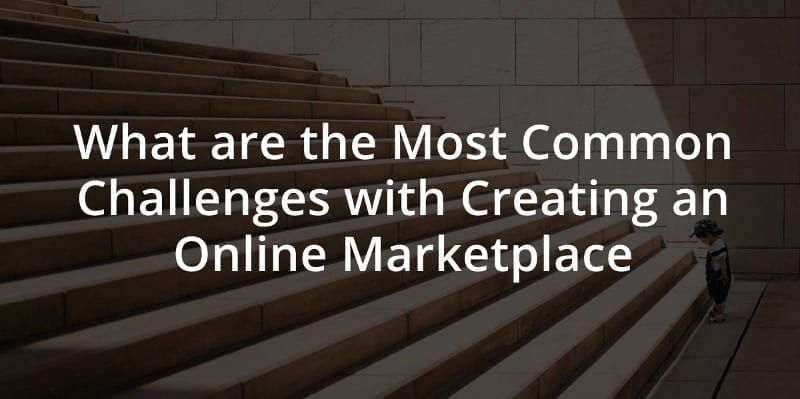What are the Most Common Challenges with Creating an Online Marketplace
When Jeff Bezos founded the internet marketplace platform Amazon in 1994, he was working at a desk which he made out of a wooden door, to avoid additional costs.
Much water has flown under the bridge within 24 years. Now, the virtual marketplace platform is showing 60.5 billion dollars revenue, with 1.86 billion in net income in the fourth quarter of 2017, and Jeff Bezos is the richest man in the world.
It shows that the online marketplace as a business makes it possible to gain the fortune amount which would take tens and hundreds of years to make in many other industries.
What often remains behind the scenes though, are the challenges that you need to overcome to gain such a success.
You may also be interested:
1. Getting the Initial Traction
The pledge of success with an online marketplace mall creation is to find an idea that will be in demand for the intended audience.
1.1 Define a concept that works
New online marketplaces are popping up every day, and many niches have been filled out already. To enter the market now, having just a great idea isn’t enough.
There should be a complete understanding of why the intended audience would need a shopping mall:
- it is a new and useful service or concept that haven’t existed before;
- it solves customers’ existing problem;
- it enables a high frequency of transactions, and thus, high virtual marketplace liquidity.
Airbnb, for example, solved the real issue of its customers: travelers couldn’t find a place to stay.
If they didn’t want to use hotels, there were almost no other variants. It was hard to find listings, and those that were available had no apartment photos. No tools to ensure that it’s secure to stay with a particular host—or invite a particular guest—existed.
By providing apartment photos of great quality, host and guest reviews, and identity verification, the online mall was able to solve all the problems that its audience had.
As the chart shows, even though the online marketplace mall was founded earlier, the exact moment when its photographers provided good quality pictures for listings was the tipping point for the shopping mall growth.
The chart of Airbnb traction gaining process (amount of users / years):
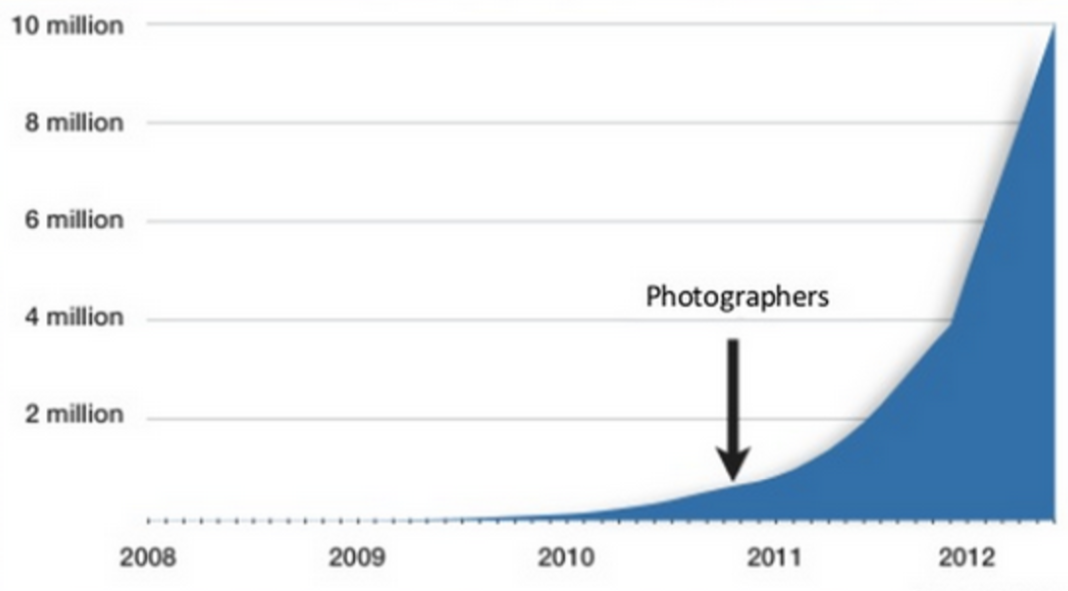
Great quality of pictures is still the one of the internet marketplace platform main characteristics:

Fril, a Japanese online flea ecommerce marketplace for women only (now is acquired by Rakuten), has leveraged the fact that Japanese women sell all their clothes when they go to college, and when they graduate as well.
The virtual shopping mall matched the intended audience’ needs, and since each customer was also a vendor, the founders acquired both sides of the marketplace simultaneously.
A high level of transaction frequency enables high marketplace liquidity, which is more important to a new online marketplace mall than getting the largest revenue per transaction.
Besides the fact that high liquidity enables more frequent financial income, it influences customers’ behavior by turning an online mall into a go-to platform, for them to satisfy a particular need.
For example, Uber’s transaction size is small, but its frequency is high; thus the marketplace was able to create a high level of liquidity.
1.2 Create supply and demand
Even if you have a good virtual marketplace concept in place, to gain traction, you need to embrace the intended audience successfully.
It’s necessary to have a particular idea on how to create supply or demand artificially, in case if the organic approach doesn’t work.
Airbnb initially targeted huge events in their area, to gain customers when surrounding hotels were completely booked.
To provide supply, they contacted all the suppliers who listed short-term rentals at Craigslist and invited them to list at their platform.
Besides, they integrated with Craigslist’ platform to allow suppliers to easily create listings on Craigslist through Airbnb, what made Airbnb a go-to platform because of its convenient ecosystem.
To find customers, Uber leveraged the local characteristics of the San-Francisco area by offering free rides to tech people attending IT conferences, making word of mouth the marketplace’s biggest driver.
1.3 Increase the number of seller-buyer matches
When running a marketplace, you will constantly have updated data on the price of products, the search terms that drive traffic, and other data which can help sellers match client expectations and increase the number of successful transactions.
Right stock
By constantly analyzing customers’ organic search within a marketplace, you can extract some useful insights for your sellers.
When Etsy noticed many searches for owls, they’d informed their artisans for them to start producing more owl-related goods:

Right pricing
Having all the data about average costs and rates for goods and services on a marketplace, you can create updating guidelines for sellers to define the best pricing.
It’ll help them prepare more relevant offers and increase the number of successful transactions.
Etsy offers analytics to improve vendors’ sales:

Right product presentation
The sellers’ content (pictures and descriptions) will all be of different quality and format. To provide a unified user experience and to create an efficient conversion funnel, help vendors adhere to unified listings policies while staying unique. Etsy created an educational system to help vendors create listings, which are good photographs and copy:

Once the traction is gained, the next challenge is to ensure a stable marketplace development.
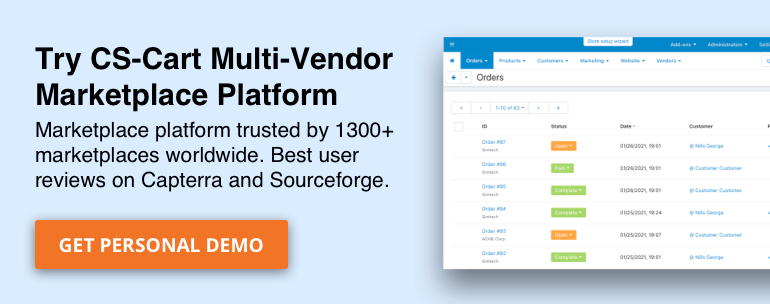
True Experience #1

Fiona Adler writes about entrepreneurship at DoTheThings.com and is the founder of Actioned.com—a productivity tool for individuals and teams. With an MBA, multiple business successes, and a family living in a foreign country, she enjoys pushing the envelope to get the most out of life and loves helping others do the same.

My last business was an online reviews platform —essentially an online marketplace for consumers to connect with local businesses. Eventually, my business partner and I grew this to become the largest in Australia and it was acquired (www.wordofmouth.com.au).
Clearly, the major challenge of building an online marketplace is that it requires a critical mass on both sides of the market—sellers are not interested in participating if there is not sufficient traffic and users, and users don’t see the value until there are sufficient sellers.
What surprised me with this type of business was how long it took to achieve this critical mass. In many cases, it requires an inordinate effort from the business to create enough activity in the marketplace until it gains a momentum of its own.Persistence really is key!For us, it also helped to focus on one city at a time—but for ecommerce this might mean focusing on a subset of your industry at a time.
2. Ensuring Sustainability
Boosting traffic through advertisement isn’t a sustainable business model from a long-term perspective. Customers don’t go to Internet marketplace platforms Etsy, Amazon, or AirBnB by clicking on advertising or paid search results.
An online marketplace mall long-term growth comes from clients’ actions within a shopping mall, thus a convenient tool-set ecosystem is a must.
2.1 Provide an ecosystem
To have sustainable growth and to retain existing clients, an online mall can’t afford being just a medium but should provide certain functions that clients need.
Besides, if you don’t offer valuable tools and services to facilitate transactions, your virtual marketplace platform concept can be copied easily.
A multi vendor center ecosystem that is full of value-added tools makes it harder for someone to steal your supply or demand. That’s the reason why many modern virtual marketplaces shift to being technology-first platforms.
An advanced online mall ecosystem embraces:
- payment tools
The competitive payment tools may include a bunch of features, but the best is to choose those that fit your marketplace needs. For example, if it is a service marketplace, payment tools should include escrow to provide trust for suppliers.
Tools to enable cross-border, multi-currency transactions, and various payment options should be in place:
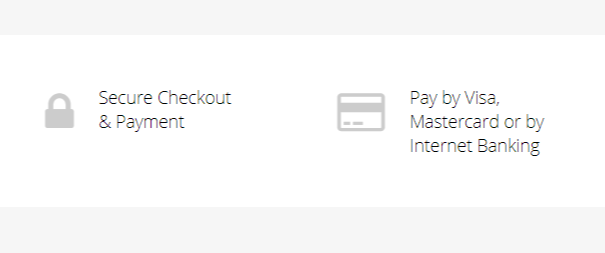
Mode, one of New Zealand’s largest online fashion malls, provides not only different payment variants as shown above, but also a pay-later option:

It’s good if a payment tool helps to work with multiple sellers: allows to implement payouts through a large range of local and international options.
To fit buyers’ needs, it’s good to have customizable checkout pages, including a quick-shop option for customers to checkout in one-click:

- analytics capabilities, including advanced tools for price management and control, and integration with external monitoring and analyzing tools;
- a CRM system, with all the necessary integrations with sellers’ databases, and real-time inventory updates—to avoid incorrect information about the products on the multi vendor center.
If this is a B2B virtual marketplace, special attention should be paid to integration. B2B-sellers—organizations, that are running on their own order, sales, warehouse management systems, which should be integrated flawlessly into a web marketplace software.
- advanced design features—since items photos and descriptions are the part of the conversion funnel, it’s necessary to provide sellers with tools to design and structure their listings.
Yumbles, an online marketplace mall that is connecting food lovers, provides an ecosystem that allows sellers design their mini-shops with unique details, still keeping the marketplace’ unified design structure among all vendors:
The Cheese & deli category listing (with the additional photos of the listing)

The Just discovered category listing (without the additional listing photos)

2.2 Build growth through network effects
One of the most efficient ways to support an Internet marketplace platform’ sustainable growth is network effects.
Jonathan Golden, who was building a product at Airbnb for six years, highlights two types of network effect. Both types can enable sustainable development, but the way to grow supply and demand for each type is different:
- global network effects
Jonathan Golden’s global network effects infographic:
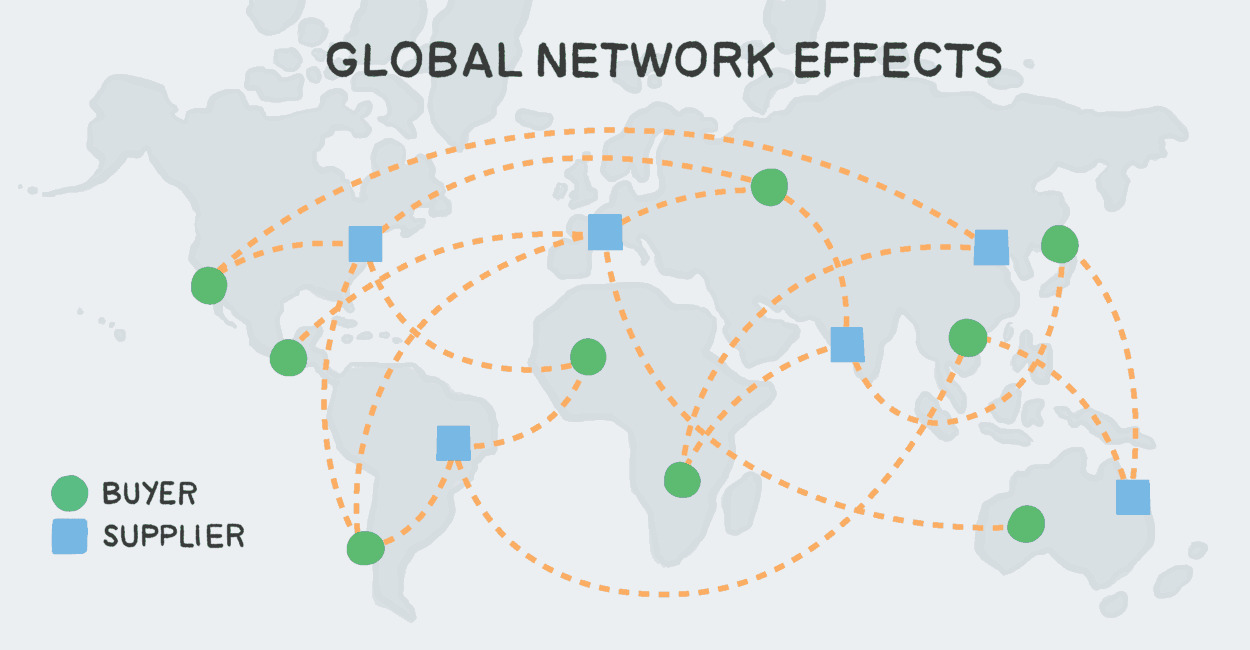
Airbnb is a bright example of the type. Every new listing brings the same value to all customers, regardlessly of their location. Travel is global, and a customer from any place can rent an apartment anywhere.
Global network effects grow organically. Airbnb listings appear from anywhere, and any traveler can use them.
- root density network effects
Jonathan Golden’s root density network effects infographic:
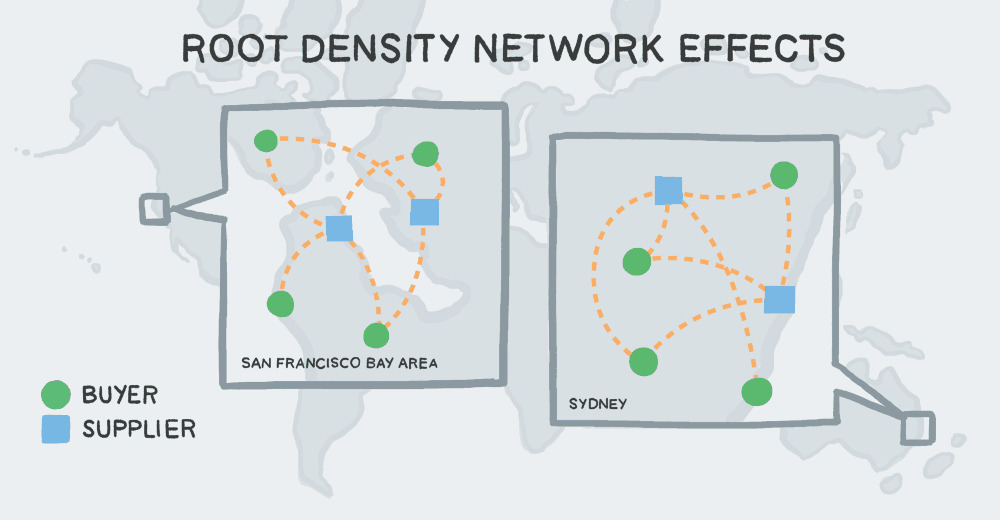
In this case, each local market grows independently, so one local market’s supply gains nothing from demand growth in another local market.
As an example—Uber’s multivendor mobile app is intended for local usage. Also, if just one driver works on a market, it would provide no value to customers.
In this case, a network grows from being the first mover who is actively building supply in each local market independently.
2.3 Ensure customers’ retention
The most efficient way to retain customers is following their needs and expectations, anticipating and satisfying them on the way.
Besides constant customer data analyzing, there are other pillars of users’ retention—a customer service.
There are few main challenges an online marketplace encounters while building a customer service:
- enabling quick responses: over 80 percent of customers expect a response on social media within 24 hours, and within an hour—via email, according to the Spider Marketing survey;
- being constantly updated on each customer data: transaction and previous communication history and other information.
There are two main directions to overcome those challenges:
1. Build a special procedure for processing customer requests:
a) in the omnichannel context;
b) based on your customers’ unique needs and characteristics;
2. Regular customer service team trainings.
As a result, multi vendor centers are gaining sustainable growth, and are becoming a default go-to place for customers like AirBnB, eBay, or Etsy.

True Experience #2

Mark Williams, CEO at ShavingCream.com, an eCommerce marketplace selling grooming products and based in Menlo Park, California
Here are some challenges we face and how we work to overcome them:
- Developing the CS-Cart Platform. Learning the CS-Cart Multi-Vendor application was an initial challenge. There remains much for me to learn about it, as it is a comprehensive tool and I am a marketer, not a developer. I’ve worked hard to learn the application and thankfully, the CS-Cart technical team has been very helpful in supporting me efforts.
- Featuring Compelling Sellers. Developing a compelling selection of sellers is a challenge. Our marketplace operates in a very competitive sales environment where some of the world’s most well-known companies are active, established sellers. A clear vision, careful prospecting, targeted communications, persuasiveness, perseverance, flexibility, and patience are all called for here.
- Search Advertising / SEO. Developing and maintaining an effective and efficient online search advertising campaign and SEO presents their own learning-curve-associated challenges. Again, a creative, ongoing effort is called for here, on both fronts, to earn rewarding results.
- Selling. Driving sales is and will be our biggest challenge. The relative effectiveness of our solutions to our challenges drives sales. We are working to develop new markets and new customers for sellers. We strive to collaborate and coordinate our advertising and marketing with sellers.
Conclusion.
Finding the time to accomplish all that needs to be done is challenging. Prioritize. Stay positive. The online marketplace model is the future of Internet sales. Lead with confidence, integrity, and hard work.
3. The Problems That Come with Success
3.1 Security
There are few elements of e-commerce security a multi vendor center should enable.
Fraud
Fraud can appear on a virtual marketplace platform in a different shape and form. Apart from the scams targeting customers’ credit card details and personal data, other fraud cases are popped up recently.
Counterfeit sites creation
Airbnb’s legitimate listing had been stolen: the fraudsters changed its details and set up a fake homepage.
Later, the listing instructed the customer to email the owner directly to check their availability, and after that, the customer was provided via email with the fake links to make a payment.
Since the fraud had technically been held outside the online mall, there were not many options for the Internet marketplace to solve the situation.
Thus, in such cases, the best is to establish detailed guidelines on how to avoid such a fraud for customers in advance.
The quality and veracity of listings
After a big wave of fraud—Amazon encountered new vendors, who were selling fake listings—the marketplace changed its policies. From allowing new vendors to post an unlimited amount of goods, the virtual marketplace platform now allows the posting of only small items amount until sellers prove themselves.
The measures helped to decrease the number of scam sellers very quickly.
The Amazon fraudulent sellers volume:
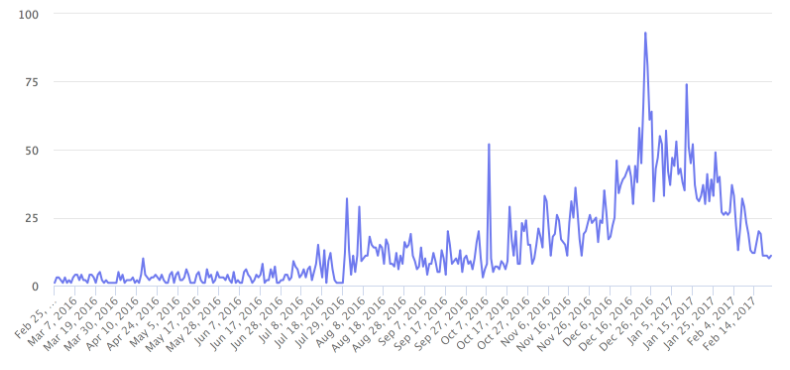
The multi vendor center has a chargeback program as well, which lets you refund the money to a buyer in case of fraud.
There are also other few points that should be covered to enable security:
- confidentiality—sensitive data, like buyers’ credit card number, should be encrypted well;
- private information, like users’ contacts, should be secured, and terms of private info usage should be in place for employees and users within an online mall;
- strong virtual marketplace data access control: multi-factor users and employees authentication and identity verification.
3.2 Platform circumvention
Mature Internet marketplaces face an additional challenge of circumvention, which can be countered in several ways:
- by providing trust: convenient payment tools that build trust between sellers and customers;
- by preventing clients from seeing each other’s contacts until the deal is done;
- by ensuring convenience with value-added services.
For example, Airbnb platform’ tools help a multi vendor center to provide trust and convenience by offering:
- identity verification and reviews;
- assurance to support customers in case of apartment damage;
- a payment feature ;
- a messaging tool to communicate easily.

True Experience #3
Madhupani Jayasuriya, the Head of the MondeShoppingSpree marketplace
Starting an online marketplace is not as difficult as one can imagine, though you need to invest some money. There are various online market platforms available to use either on monthly basis payment or one time payment. However, some ecommerce platforms need technical knowledge to work with and support.
After considering the available online market software solutions according to their features, price, the support provided by the service provider, and the reviews on these multi vendor platforms, one can decide which program to choose for creating an online marketplace. We have decided to use the CS-Cart Multi-Vendor platform because of the specific and attractive features of the marketplace script as well as their excellent support provided.
We have faced lots of challenges in designing the Internet marketplace. The CS-Cart online marketplace script comes with cool designing tools and therefore, the online mall can be designed with some technical knowledge. But other challenges include finding sellers and customers by communicating with them and setting up advertisements in Google or Facebook.
The best approach to overcome all the challenges while creating a marketplace is based on the few components:
- going after customer needs: interact directly with users, and analyze and use a web marketplace customer data as a perpetual survey of your buyers—to build a multi vendor center that users enjoy being a part of, and would want to share with their friends;
- enabling sustainable growth through a wisely-built network effect and advanced tool-set ecosystem and infrastructure.
The Amazon Culture of Metrics—analyzing each detail of the marketplace performance to build an efficient ecosystem and the best experience for customers is a bright example of such an approach.
This approach is something that definitely helped the virtual marketplace platform to thrive, while the initial pledge of success—the Jeff Bezos’ door-desk story, is slightly turning into a marketing legend with time.

Yan Anderson is the Head of Content Marketing at CS-Cart with over 10 years of experience in the eCommerce industry. He's passionate about explaining complicated things in simple terms. Yan has expertise in building, running and growing eCommerce marketplaces. He loves to educate people about best practices, new technologies, and trends in the global eCommerce industry.
